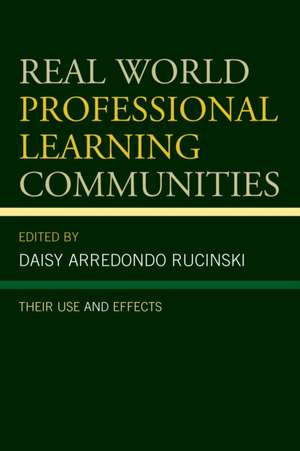Real World Professional Learning Communities
Autor Daisy Arredondo Rucinskien Limba Engleză Paperback – 22 noi 2016
| Toate formatele și edițiile | Preț | Express |
|---|---|---|
| Paperback (1) | 328.65 lei 6-8 săpt. | |
| Rowman & Littlefield – 22 noi 2016 | 328.65 lei 6-8 săpt. | |
| Hardback (1) | 487.71 lei 6-8 săpt. | |
| Rowman & Littlefield – feb 2017 | 487.71 lei 6-8 săpt. |
Preț: 328.65 lei
Nou
Puncte Express: 493
Preț estimativ în valută:
62.90€ • 65.16$ • 52.49£
62.90€ • 65.16$ • 52.49£
Carte tipărită la comandă
Livrare economică 21 martie-04 aprilie
Preluare comenzi: 021 569.72.76
Specificații
ISBN-13: 9781475822816
ISBN-10: 1475822812
Pagini: 210
Dimensiuni: 152 x 229 x 16 mm
Greutate: 0.32 kg
Editura: Rowman & Littlefield
ISBN-10: 1475822812
Pagini: 210
Dimensiuni: 152 x 229 x 16 mm
Greutate: 0.32 kg
Editura: Rowman & Littlefield
Notă biografică
By Daisy Arredondo Rucinski
Cuprins
Foreword¿Terri Croft Boman
Part I ¿Overview of book
Chapter 1: Introduction
Chapter 2: The Conceptual framework for Professional Learning Communities as Reform Initiatives
Daisy Arredondo Rucinski (Example of use by Kyra L. Rhyne)
Part II ¿ Use of PLCs in Elementary Schools
Chapter 3: Teacher reflection and teacher development in elementary schools using Alabamäs Instructional Partners Program (IPN)
Bradley A. Scott, Principal, Chaffee Elementary School, Huntsville, AL
Chapter 4: Elementary teacher reflection in professional learning communities and teacher learning
Rachel Real Poovey ¿ Supervisor of Elementary Education, Decatur, AL City Schools
Chapter 5: Using PLC collaboration as a foundation for trust and teacher efficacy in elementary schools
Datie I. Priest ¿ Principal, West Decatur Elementary School, Decatur, AL
Part III ¿ Use of PLCs in middle and high schools
Chapter 6: Relationships among professional learning communities, trust, and student achievement in elementary and middle school mathematics.
Herbert A. Betts III ¿ Madras Middle School, Assistant Principal, Coweta School System, Newnan, GA
Chapter 7: School Culture, Professional Learning Community and Student Achievement in Middle and High Schools
Amanda Hitson Cassity ¿ District curriculum director, Northern Region, Tuscaloosa County Schools, Tuscaloosa, AL
Chapter 8: Common Planning in High School Departments: A Structure for Implementing Professional Learning Communities
Kyra L. Rhyne ¿ District coordinator for virtual learning, Catoosa County Schools, Ringold, GA
Part IV ¿ School, District, and State contexts in using PLCs as a school reform and accountability strategy:
Chapter 9: Using a professional learning community framework to support response to intervention (RTI) in middle and high schools
Nicole Spiller ¿ District Director of Student and Intervention Services, Atlanta School System, Atlanta, GA
Chapter 10: Developing schools as professional learning communities: Does district level leadership matter?
Terri Croft Boman ¿ University ¿ K-12 Professional Development Director
Chapter 11: Professional development in the states: How statutes and regulations target teacher quality to improve student learning
Helen M. Hazi, Professor, West Virginia University and Daisy Arredondo Rucinski ¿ Professor, The University of Alabama
Part V ¿ What the research says about the effects of using PLCs in schools and student or teacher learning:
Chapter 12: Meta analyses of the research
Part 1: A meta-analytic review of dissertation research on Use of PLCs and student achievement
Part 2: A Meta-analytic Review of the Published Research on Use of PLCs and Student and Teacher Learning.
Susan McClendon Patrick, Secondary Curriculum Supervisor, Cullman County Schools, Cullman, AL; Daisy Arredondo Rucinski, Professor; and Sara Elizabeth Tomek, Associate Professor, UA.
Chapter 13: Conclusions, limitations, and implications for future research
Daisy Arredondo Rucinski
Index
Descriere
In a professional learning community, teachers are organized into teams, committed to meeting on a regular basis to study their teaching strategies and the effects of those strategies on the students in their classrooms. Whatever the organizational structure, the teams have one goal, that is to improve teaching so that student learning is improved.
